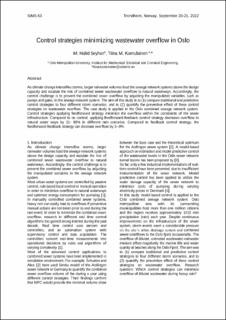Control strategies preventing wastewater overflow in Oslo
Peer reviewed, Journal article
Published version

View/
Date
2022Metadata
Show full item recordCollections
Original version
Linköping Electronic Conference Proceedings. 2022, 192 25-32. https://doi.org/10.3384/ecp192005Abstract
As climate change intensifies storms, larger rainwater volumes load the sewage network systems above the design capacity and escalate the risk of combined sewer wastewater overflow to natural waterways. Accordingly, the control challenge is to prevent the combined sewer overflow by adjusting the manipulated variables, such as pumps and gates, in the sewage network system. The aim of this study is to (1) compare traditional and predictive control strategies to four different storm scenarios, and to (2) quantify the preventive effect of these control strategies on wastewater overflow. The case study is applied in the Oslo combined sewage network system. Control strategies applying feedforward strategy minimize the overflow within the constraints of the sewer infrastructure. Compared to no control, applying feedforward-feedback control strategy decreases overflow to natural water ways by 21- 88% in different rain scenarios. Compared to feedback control strategy, the feedforward-feedback strategy can decrease overflow by 3--9%.
